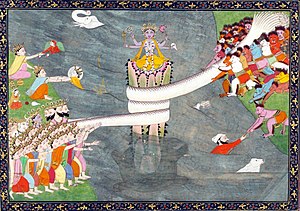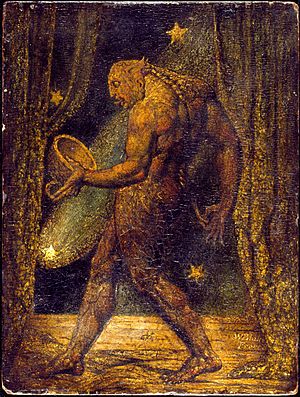Non-human races in Hinduism
Script error: No such module "Draft topics". Script error: No such module "AfC topic".
Hindu mythology has lot of Non - Human Races. This refers
Devas[edit]

They are sons of Kashyapa Prajapati and Aditi. and called as adityas. [1] They are good in nature. They lived in Swarga. They are mainly Gods. They are immortal and Drink Amrita for their immortality. Their king is called as Indra.[2] They give boons to Humans.
Daityas[edit]
They are sons and their heirs of Kashya Prajapati and Diti. They are evil in nature. They are devils. They have rivalry with devas for swarga. They are not immortals. They normally live in Patala.[3]
[edit]

The danavas are a race descending from Kashyapa and his wife Danu, a daughter of the progenitor god, Daksha. [4] It is mentioned that there are one hundred danavas.
The danavas are a mythological race of asuras, the half-brothers to the devas and daityas that are found in a range of Hindu texts. The danavas are a part of a larger group of the asuras, and are typically portrayed as opposed to the Hindu deities.
Nagas[edit]

The Nagas are a divine, or semi-divine, race of half-human, half-serpent beings that reside in the netherworld (Patala), and can occasionally take human or part-human form, or are so depicted in art. A female naga is called a Nagi, or a Nagini. According to legend, they are the children of the sage Kashyapa and Kadru.
Gandarvas[edit]

A gandharva is a member of a class of celestial beings in Dharmic religions such as Hinduism whose males are divine performers such as musicians and singers, and the females are divine dancers. In Hinduism, they are regarded to be the celestial demigods who serve as the musicians of the devas. As per Puranas they are children of Sage Kashyapa and His wife Prada
kinnara[edit]

In Hindu mythology, kinnara is described as half-man, half-horse, and half-bird. The Vishnudharmottara describes Kinnara as half-man and half-horse. They are mentioned along with Devas, Gandharvas, Charanas, Siddhas, and Apsaras in mythological texts. kinnaras are innocent and harmless, hop like birds, are fond of music and song, and with the female beating a drum and male playing on lute.
Kimpurush[edit]
The kimpurushas are a race of beings featured in Hindu literature. They are described to possess the bodies of human beings and equine heads. They are associated and sometimes regarded to be the same as the kinnaras, though some Puranas offer them a distinction. The kimpurushas are also described to be the attendants of the god of wealth, Kubera.
Yaksha[edit]

The Yakshas are a broad class of nature-spirits, usually benevolent, but sometimes mischievous or capricious, connected with water, fertility, trees, the forest, treasure and wilderness. They appear in Hindu texts as guardian deities.
Kubera also known as Kuvera, Kuber and Kuberan, is the god of wealth, and the god-king of the semi-divine yakshas in Hinduism. He is regarded as the regent of the north (Dikpala), and a protector of the world (Lokapala). His many epithets extol him as the overlord of numerous semi-divine species, and the owner of the treasures of the world. Kubera is often depicted with a plump body, adorned with jewels, and carrying a money-pot and a club.
Rakshas[edit]

Rākshasas are a race of usually malevolent beings prominently featured in Hindu mythology. They reside on Earth but possess supernatural powers, which they usually use for evil acts such as disrupting Vedic sacrifices or eating humans. They are offered a distinction from yakshas, their cousins who are depicted to be forces of destruction.
Rakshasas were a populous race. There were both good and evil rakshasas, and as warriors they fought alongside the armies of both good and evil. They were powerful warriors, expert magicians and illusionists. As shape-changers, they could assume different physical forms. As illusionists, they were capable of creating appearances which were real to those who believed in them or who failed to dispel them. Some of the rakshasas were said to be man-eaters, and made their gleeful appearance.
Bhoota[edit]

A bhoota or bhuta is a supernatural creature, usually the ghost of a deceased person. They are usually considered to be perturbed and restless due to some factor that prevents them from moving on (to transmigration, non-being, nirvana, or swarga or naraka, depending on tradition). This could be a violent death, unsettled matters in their lives, or simply the failure of their survivors to perform proper funerals.
Pretas[edit]

Preta , also known as hungry ghost, is the Sanskrit name for a type of supernatural being described in Hinduism as undergoing suffering greater than that of humans, particularly an extreme level of hunger and thirst.
Pishashas[edit]
Pishachas are flesh-eating demons appearing in Hindu mythology A pishacha is a malevolent being that has often been referred to as the very manifestation of evil.
the sons of either Krodha or as Dakṣa’s daughter Pischcha. They have been described as having bulging veins and protruding red eyes. They are believed to have their own languages, known as Paiśāci. According to one legend, they are sons of Kashyapa and Krodhavasa, one of the daughters of Prajapati Daksha. Pischchas are supposed to possess the ability to shapeshift and assume any form at will, and may also become invisible. They also feed on human energy. Sometimes, they possess human beings and alter their thoughts, and the victims are afflicted with a variety of maladies and abnormalities like insanity.
sidhdhas[edit]
Siddha is a term that is used widely in Indian religions and culture. It means "one who is accomplished." It refers to perfected masters who have achieved a high degree of physical as well as spiritual perfection or enlightenment. In Jainism, the term is used to refer to the liberated souls. Siddha may also refer to one who has attained a siddhi, paranormal capabilities.
Sadyas[edit]
The sadhyas refers to a class of minor deities in Hinduism. According to the Puranas, they are the sons of Dharma and Sadhya, a daughter of Daksha. Numbering either twelve or seventeen according to various texts, the sadhyas are described to be the embodiments of the rituals and hymns of the Vedas. They are stated to reside with the devas, or dwell in the region between heaven and earth.
charanas[edit]
Charanas are inferiors demi gods referred in many Hindu dramas. Charanas are said to be heavenly spirits, who are often introduced into Hindu dramas and represented as mingling freely with human beings. Charanas intermingle with mortals and even elect earthly princes and heroes to be their leaders and rulers. It is difficult to describe accurately the persons, character and offices of the various inferior races of divinities.
Apsaras[edit]
An apsaras or apsara is a member of a class of celestial beings in Hindu culture. They are originally a type of female spirit of the clouds and waters, who later plays the role of a "nymph" or "fairy". They figure prominently in the sculpture, dance, literature and painting of many Indian and Southeast Asian cultures. The apsaras are described to be beautiful, youthful and elegant, and are said to be able to change their shape at will. There are two types of apsaras—laukika (worldly) and daivika (divine). They are superb in the art of dancing, and often wives of the gandharvas, the court musicians of the king of the gods, Indra. The apsaras reside in the palaces of the gods and entertain them by dancing to the music made by the Gandharvas. The 26 apsaras of Indra's court are each said to symbolise a different facet of the performing arts, drawing comparisons to the Muses of ancient Greece. They are also renowned for seducing sages in order to prevent them from attaining divine powers. Urvashi, Menaka, Rambha, Tilottama and Ghritachi are the most famous among the apsaras.
Asuras[edit]
Asuras are a class of beings in Indic religions. They are described as power-seeking demons related to the more benevolent Devas (also known as Suras) in Hinduism. According to Hindu scriptures, the asuras are in constant battle with the devas. Asuras are described in Indian texts as powerful superhuman demigods with good or bad qualities. In the earliest layer of Vedic texts Agni, Indra and other gods are also called Asuras, in the sense of their being "lords" of their respective domains, knowledge and abilities. Asuras are part of Hinduism along with Devas, Yakshas (nature spirits), Rakshasas (fierce man-eating beings or demons), Bhutas (ghosts) and many more. Asuras have been featured in many cosmological theories and legends in Hinduism
Vidyadhara[edit]
Vidyadhara(s) (Sanskrit Vidyādhara, meaning "wisdom-holders") are a group of supernatural beings in Indian religions who possess magical powers. In Hinduism, they also attend Shiva, who lives in the Himalayas. They are considered Upadevas, or demi-gods.
In the Hindu epics, Vidyādharas are described as essentially spirits of the air. They are described as doing different activities in the epics like gazing at human prowess with astonishment, strewing flowers watching a combat, rejoicing with music and laughter, crowned with wreaths and fleeing with their wives from danger. They possess great magical powers like the ability to diminish their size. They are endowed with epithets describing them as "doers of good and devoted to joy". They also live in Gandhamandhana mountain and other Himalayan mountains with Kinnaras.
Guhyakas[edit]
Guhyaka(s) (गुह्यक, literally "hidden ones") is a class of supernatural beings in Hindu mythology. Like Yakshas (nature-spirits), they are often described as attendants of Kubera, the god of wealth, and protect his hidden treasures. Guhyakas are believed to live in mountain caves; thus their name, "hidden ones". As lord of Guhyakas, Kubera is called "Guhyakadhipati".
source[edit]
- ↑ "Maharshi Kashyapa Information". 19 December 2013.
- ↑ "Lord Indra".
- ↑ "Daitya". 30 May 2022.
- ↑ "Danavas".
This article "Non-human races in Hinduism" is from Wikipedia. The list of its authors can be seen in its historical and/or the page Edithistory:Non-human races in Hinduism. Articles copied from Draft Namespace on Wikipedia could be seen on the Draft Namespace of Wikipedia and not main one.
